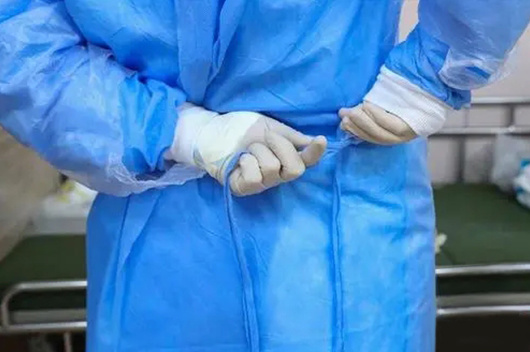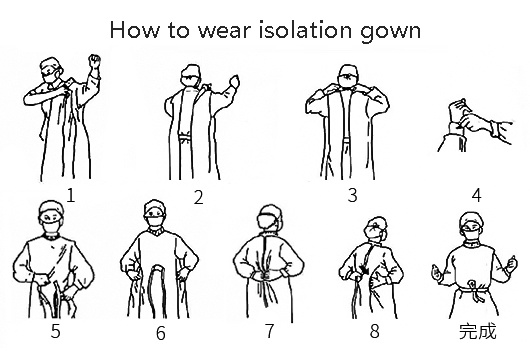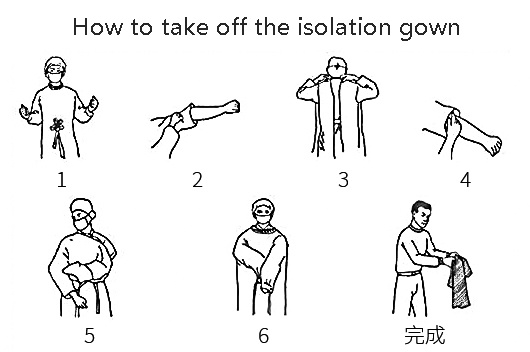Summary
Isolation gowns are mainly used to protect medical staff from being contaminated by blood, body fluids and other infectious substances, or to protect patients from infection. The editor of Linghe Technology has organized the process of putting on and taking off disposable gowns so that everyone can better use disposable gowns to protect their own occupational safety and health.

1. Steps to wear isolation gown
(1) Preparation before dressing: wear a mask and a hat (no nose and mouth exposed), remove the watch, roll the sleeves over the elbow, and wash your hands.
(2) Take out the clothes: take the isolation gown with the clothes in hand, clean the side facing you; fold the two ends of the collar outwards, align the shoulder seam, and expose the inner mouth of the sleeve.
(3) Wear sleeves: hold the collar with your right hand, and reach into the sleeve with your left hand; pull the collar upward with your right hand to expose the left glove. Wear another sleeve with the same hair.
(4) To tie the collar and cuffs: hold the collar with both hands, buckle the collar from the center of the collar along the edge, and then tie the cuffs (the hands are contaminated at this time), and loosen the belt slip knot.
(5) Find the edge of the garment and tie the belt: gradually pull one side of the isolation gown about 5cm below the waist until you see the edge, then pinch it; pinch the other side edge in the same way, and be careful not to touch the inner surface of the garment. Then align the edges with both hands on the back, fold it to one side, hold the fold with one hand, and pull the waistband to the back to press the fold with the other hand, cross the waistband on the back, and tie it back to the front.

Second, take off the isolation gown steps
(1) Untie the belt and tie a slip knot in the front.
(2) Untie the two cuffs and insert part of the sleeve into the sleeve at the elbow to facilitate disinfection of hands.
(3) After disinfecting and washing your hands, unbutton the collar, put your right hand into the sleeve sleeve of your left wrist, pull down the sleeve and pass your hand; use the covered left hand to hold the outside of the right hand isolation sleeve, and pull down the right sleeve with both hands. The conversion gradually withdrew from the sleeve.
(4) Use your left hand to hold the shoulder seam from the inside of the garment and remove your right hand, then use your right hand to hold the outside of the collar and fold it, and then take out your left hand.
(5) Hold the collar with your left hand and align the two sides of the gown with your right hand (if hanging in a semi-contaminated area, the clean side of the gown is facing outwards, and when hanging in a contaminated area, the contaminated side faces outwards), and hang it on the hook. The isolation gown that you no longer wear is taken off the clean side outwards, rolled up and put into the pollution bag.

3. Matters needing attention when putting on and taking off the isolation gown:
(1) Isolation gowns can only be worn and taken off in the specified area.
(2) The length of the isolation gown must be appropriate, and the work clothes must be completely covered. Do not use if there is a hole.
(3) Keep the collar clean, and avoid polluting the collar and clean surface when putting on and taking off.
(4) Isolation gowns should be replaced, cleaned and disinfected daily. If they are wet or contaminated, they should be replaced immediately.
The above is the relevant information about the "disposable isolation gown putting on and taking off process". In special cases, it is necessary to wear a full set of medical protective equipment to ensure the health of medical staff. Formally qualified gowns must be sterilized with ethylene oxide, and their residues must be controlled, have no toxic side effects on the human body, and meet the requirements of the national medical device production license, so as to ensure that the gown has a certain protective performance.
Recommended news
